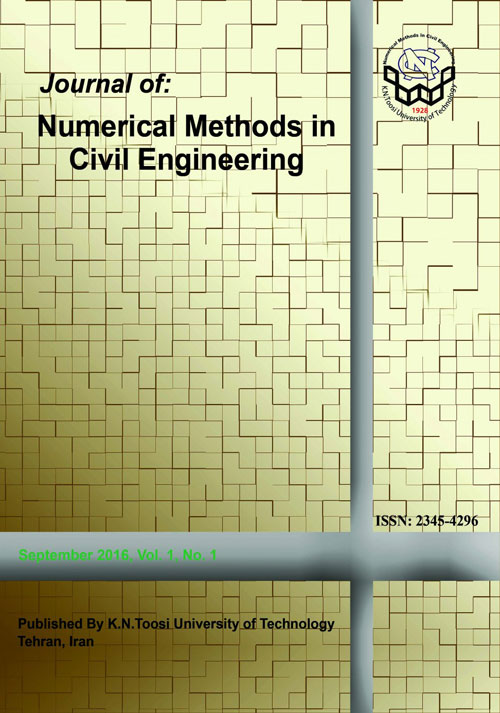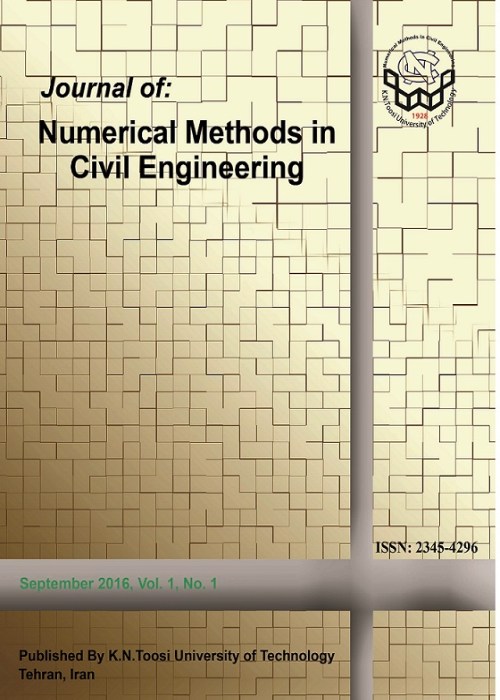فهرست مطالب

Journal of Numerical Methods in Civil Engineering
Volume:1 Issue: 4, Jun 2017
- تاریخ انتشار: 1396/07/30
- تعداد عناوین: 7
-
-
Pages 1-6Reduced Beam Section (RBS) and Drilled Beam Section (DBS) are seismic moment resistant frame connections, introduced after 1994 Northridge earthquake. RBS connection has been tested under cyclic loading and showed acceptable performance. In this paper, seismic behavior of Drilled Beam Section (DBS) connection is studied numerically using finite element method. A drilled beam section of a cantilever H-beam has been subjected to cyclic loading at its free end and studied for its optimal shapes. 62 samples of DBS connections have been modeled and studied under cyclic and pushover loadings. Based on the results obtained in this research, the connection shows its positive seismic behavior if the biggest hole is near the column face and its diameter decreases as the holes move away from the column face. In this research the effects of dimensions, position and number of holes are investigated using Von Mises stress and elastic strain criteria under cyclic and monotonic loadings. In this drilled beam the smaller holes shift plastic hinges out of the connection zone.Keywords: Reduced Beam Section, Drilled Beam Section, Cyclic Loading, Hysteretic, Energy Dissipation
-
Pages 7-15This paper introduces a new numerical method for the analysis of infilled steel frames with hollow clay blocks. This approach is based on the brittle cracking model of ABAQUS. The results of the in-plane calibration analyses obtained with four experimental tests are presented and discussed. The first test was a bare steel frame used as a control specimen. The second was similar to the first one, but with an infill wall in contact with the frame. In the third specimen, the infill wall was completely separated from the frame. The infill wall of the fourth specimen had full contact at the top of the infill wall to the frame and separated from the columns. In the second part of the study, improved versions of the third and fourth specimens have been investigated numerically. Results reveal that the brittle cracking model can be useful in assessing the behavior of masonry infill walls. Furthermore, it can be concluded that the separation of infill walls from the steel frames is quite helpful in reducing the inappropriate effects of infill walls on the overall behavior of buildings.Keywords: Infill, Steel moment frame, Masonry, Brittle cracking model, In-plane behaviour
-
Pages 16-22The vibration analysis of horizontally curved beams is generally led to higher order shape functions using direct finite element method, resulting in more time-consuming computation process. In this paper, the weak-form mixed finite element method was used to reduce the order of shape functions. The shape functions were first considered linear which did not provide adequate accuracy. Accordingly, Adomian decomposition method was employed to enrich the shape functions. As a result, the error percentage reduced significantly. The present method was validated by solving different examples and comparing the results with those reported by other researchers.Keywords: Mixed finite element, Adomian decomposition method, Out-of-plane vibration, dynamic analysis, horizontally curved beams
-
Pages 23-31In this paper, the finite difference method (FDM) is applied to investigate the stability analysis and buckling load of columns with variable flexural rigidity, different boundary conditions and subjected to variable axial loads. Between various mathematical techniques adopted to solve the equilibrium equation, the finite difference method, especially in its explicit formulation, requires a minimum of computing stages. This numerical method is therefore one of the most suitable and fast approaches for engineering applications where the exact solution is very difficult to obtain. The main idea of this method is to replace all the derivatives presented in the governing equilibrium equation and boundary condition equations with the corresponding forward, central and backward second order finite difference expressions. The critical buckling loads are finally determined by solving the eigenvalue problem of the obtained algebraic system resulting from FDM expansions. In order to illustrate the correctness and performance of FDM, several numerical examples are presented. The results are compared with finite element results using Ansys software and other available numerical and analytical solutions. The competency and efficiency of the method is then declared.Keywords: Elastic stability analysis Buckling load Non-prismatic columns Finite difference method
-
Pages 32-37Previous research on bracing members show that the ductility of bracing members is compromised due to the buckling phenomena. Therefore, many researchers have tried to use special considerations to increase the fracture life of bracing members. Some of these recommendations such as increasing the slenderness ratio, using lower width to thickness ratio, increasing the out-of-plane stiffness of middle connection to increase the fracture life of the bracing members can be used in seismic upgrading of bracing members. In this paper, the buckling behavior of a special type of concentrically braced frame termed as yielding damped braced core is investigated for different percentage of central core. Empirical studies shows that separation of X-braces by central frame, influence the buckling behavior of the system and leads to occurrence of buckling in second mode shape in accordance with two half-sine wave. The theoretical studies shows that the buckling strength of the system increases in proportion to increase in central core rigidity. Using more flexible central core, results in increase the possibility of instability and vice versa. Hence, to enhance the buckling behavior of the system, it is strongly recommended to use a central core with proper rigidity.Keywords: Yielding Damped Braced Core, Effective Length Factor, Empirical Test, Seismic Performance, Buckling, Central Core
-
Pages 38-44The theory of optimization has improved remarkably during the last four decades. The main part of optimizing investigations has been focused on enhancing buckling resistance which does not violate the economic feasibility of final design. The finite element analysis which is called ESO (Evolutionary Structural Optimization) is presented for optimum (or most ideal) design of columns to increase the buckling resistance of structures. To attain the significant design variables, this method can be employed to choose an appropriate, affective and economical way. During an iterative process, the above approach ensures the attainment of global maximum critical load under the imposed equality volume constraint, type of boundary conditions and type of cross sections. Precise results and numerical examples have been shown and useful diagrams have been developed for the cases of simple, clamped and clamped free supported by different types of cross-sectional areas. The model has succeeded in arriving at the global optimal column designs possessing the absolute maximum buckling load without violating the economic feasibility requirement. As a matter of fact, the cross sectional area of column changes whereas, the total volume of column remains constant. As a result, the buckling forces increase. According to this study critical buckling load of columns decreases by changing the boundary condition from clamped to clamped free and then simply supported.Keywords: Optimum design Buckling Resistance Eigenvalue Sensitivity number Elastic column
-
Pages 45-53A two-dimensional fully implicit finite difference model, which can be easily extended to three dimensions, is developed to study the effect of cut-off walls on saltwater intrusion into the aquifers. This model consists of a coupled system of two nonlinear partial differential equations which describe unsteady density-driven groundwater flow and solute transport. The numerical model is verified by the Henry problem. A good agreement between this model and the semianalitical solution of Henry problem shows the efficiency of this method for seawater intrusion problems. The effect of cut-off walls on reduction of saltwater intrusion in the Henry problem is investigated. Furthermore, the effect of geometric parameters of the cut-off wall such as depth and distance from the coast on repulsing saltwater is considered. Subsequently, the application of the presented model is considered to evaluate the effect of cut-off wall on repulsing salt water intruded by a pumping well located above the transition zone, which demonstrates that the cut-off wall has strong impact on repulsing saltwater intruded. For example, it repulses more than 45% salt water intruded by the discharge well in the Henry problem.Keywords: saltwater intrusion, flow, solute transport, density-driven flow, Henry problem, cut-off wall


